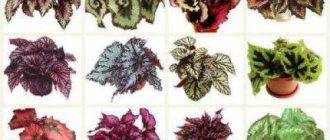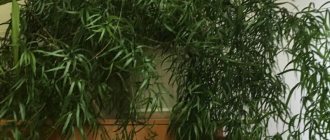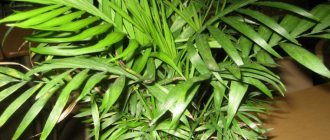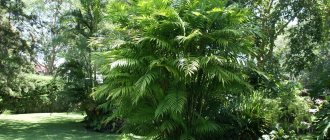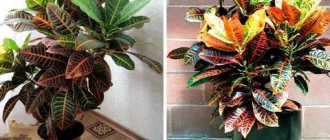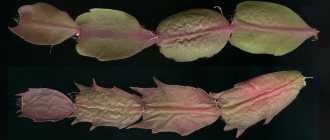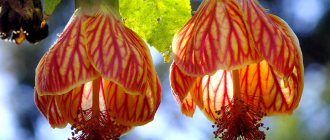Good afternoon, my dear readers. Today I again admired my beautiful begonia, but before I was quite skeptical about such plants. For understanding, let me clarify: we are talking about the Rex variety, which belongs to the group of decorative deciduous begonias, which have gained popularity precisely because of their magnificent greenery.
The flowers of such species are inconspicuous, but beautiful lush leaves successfully provide an alternative to them. Caring for them at home is not difficult, but the magnificent multi-colored greenery (and experts count up to 900 species) will bring you joy and positivity and will become a real decoration in the interior of your home.
How to care for begonias
All decorative deciduous begonias require high air humidity.
But the first problem of care is that almost all of them do not tolerate spraying and need very good ventilation of the room. Therefore, if the room has central heating and the air temperature rises above 22°C in winter, then you need to try to increase the air humidity as much as possible. If you happen to be the owner of gorgeous begonia hybrids with pubescent leaves and a painted pattern, then it is best to purchase an air humidifier, otherwise you can place the pots on wide trays with wet pebbles (expanded clay or sphagnum moss). Water from the tray should not fall into the pot. In winter, central heating radiators will have to be covered with damp towels, which should be moistened in the morning and evening. At the same time, it is not advisable to place the pots crowded together in a large dense group; this makes ventilation difficult.
Begonia growing wild, Borneo. Begonias naturally grow on leafy soil—a loose cushion of decaying leaves and wood debris.
The second problem is that most begonias are not as moisture-loving as they seem. Those. increased requirements for air humidity do not mean an increased need for soil moisture. It is necessary to water moderately, so that the soil has time to dry out in the upper third or even in the upper half of the pot before the next watering. You can check this only by touching the ground with your finger.
And the third problem is poor air movement in the apartment. When the air is very humid, above 60-70%, there is always a risk of developing pathogenic microflora - fungal and bacterial infections, which cause wet brown spots to appear on the leaves, roots and parts of the rhizome rot. So, in the absence of air circulation, with large crowding of plants (group plantings, closely spaced pots), the risk of developing these infections increases many times over. Even if you ventilate twice a day, this is usually not enough, because in natural conditions the plants are constantly blown by the wind.
Therefore, if you have high humidity at home, and black spots - fungi - have appeared on the windows or walls, then you should think about whether not only your flowers are at risk, but also the health of all family members (allergies, asthma, etc.). Usually, fungal stains on the surface of the ceiling and walls are a sign not just of high humidity, but of poor ventilation. In itself, air humidity of 50-60% is necessary and important for flowers and humans. But it is necessary to check why the ventilation in the apartment is poor: there is no ventilation, there is no draft, in the end, tightly closed plastic windows block oxygen.
But condensation on the windowsill does not mean that there is high humidity throughout the apartment. It may not be enough in the room. The best thing to do is buy a hygrometer and find out for sure. If fungal plaque appears, the only correct solution is to install a ventilation hole in the wall.
Decorative deciduous begonias are mostly very shade-tolerant. They grow well on northern window sills, but further from the window, in the back of the rooms without additional lighting, it will be dark for them, it all depends on how much sun the tulle curtains (or what you have hanging on the windows) let in. There is no concept of shade-loving plants, this was invented by people who are far from understanding what a good leafy plant should look like. And many consider deciduous begonias to be shade-loving.
In fact, most begonias prefer bright, indirect light, with some direct sun in the morning or evening. Those. East, north-west, north windows would be ideal. On windows of southern and western orientation, shading is needed, but here begonias feel bad not only from the sun, but also from the heat. In general, on particularly hot days in summer, it is better to place pots with begonias on the floor, where the temperature is 2-3°C lower.
Caring for leaf begonia at home
Features of caring for chamelacium at home
Leaf begonia is unpretentious, but grateful for care. It does not need to be stimulated to flower, put away for the winter, you just need to carry out the minimum care items, ensuring its health and immunity from disease.
Lighting
The new inhabitant of your apartment who has arrived should be placed in diffused but bright light. Usually these are south-east or south-west windows. Southern ones are suitable if there is shading, a curtain, or blinds (otherwise it may get burned).
Begonia needs 11-15 hours of daylight. The lack of light makes it less decorative. The variegation of the pattern or color may fade, and the size of leaves and stems may decrease. Therefore, placing it deeper into the room is not the best option. But you can try for a short time, what if you come across exactly the right copy?
Begonia care
It is also worth noting that begonia does not like to be moved or even moved with different sides towards the light in order to get the ideal crown of the bush. To do this, you can only rotate it a little, literally a few degrees.
Temperature and humidity
Begonia prefers a temperature range of 20-25 degrees in summer and a humidity of at least 60%. If there are deviations in temperature that cannot be changed in the apartment, you need to regulate the humidity. It can be influenced by a fine mist spray (not on the plant itself, but around it) of soft water without calcium impurities, by organizing a wide tray (for a larger evaporation area), in which expanded clay or moss should be placed and regularly moistened.
An aquarium, as well as the simplest household humidifier, can help cope with this task. Just remember to always use soft water, otherwise there will be a white coating on the flowers and on all surfaces within the range of the device.
An excess of humidity combined with low temperature will provoke rot, while a deficiency will lead to a general weakening and drying of the tips of the leaves. Spider mites quickly appear in dry air.
Watering and fertilizing
The earthen ball of the plant should not dry out too much; watering should be regular, approximately twice a week in summer and once a week in winter. But, of course, the first indicator of future normal development should be the soil. Overwatering is also dangerous, this is a direct road to fungal diseases, rotting and death. To be on the safe side, there must be drainage at the bottom of the pot and a drainage hole itself, through which excess water will drain into the pan.
Feeding starts in the spring, at the beginning of growth activation. Fertilizers are needed mainly from nitrogen for increasing mass or complex fertilizers marked “for decorative deciduous plants” or even special ones “for begonias”. Some gardeners prefer to separate mineral and organic fertilizers into different methods. You need to add them to water for irrigation once a month, and to be safe, reduce the dose slightly compared to what is indicated in the instructions.
Preparing for winter
With the onset of autumn, fertilizing should be done less frequently, and then stopped altogether, allowing the plant to rest and be at peace. They also reduce watering and temperature to 18, and later to 16 degrees. You should not lower it below 15; do not confuse the deciduous species with the tuberous one. Humidity remains the same, and in winter, when the heating is turned on in the apartments, it needs to be monitored especially carefully, using all the methods that were discussed earlier in the section on humidity. In winter, drafts and radiators are the main enemies for the health of begonias.
It will also be interesting: Begonia does not bloom - why and what to do at home
Peculiarities
At home, begonias are propagated by cuttings, seeds and tubers. However, leaf propagation is most often used. This is due to a large number of positive characteristics.
- Losing one leaf will not in any way affect the health or appearance of the plant.
- None of these steps require special skills, effort or time.
- This method can be considered the most productive: after all, about 10 shoots can be obtained from one leaf blade.
- For some begonia varieties, this is practically the only propagation option.
- Unlike propagation by seeds, you will know exactly what the future plant will look like.
- Planting material serves as a source of nutrition. Thanks to the nutrients contained in it, the shoots will grow faster than when grown from seeds.
Moreover, the sheet itself can be used in various ways:
- waiting for roots to appear by placing it in water;
- Landing in the ground.
In the latter case, you can use the entire plate or divide it into parts.
Tuberous flowers
Vallota. Features of home care
Tuberous decorative flowering begonias are grown in pots or outdoors. These plants have a pronounced dormant period.
Potted and garden begonias overwinter in different conditions. Therefore, winter care for potted and garden crops of tuberous begonias is fundamentally different.
Garden
In order to preserve the tubers of begonias growing outdoors, it is necessary to carefully dig them out of the ground when cold weather sets in. This is usually done in early October, when the air temperature drops and the plants begin to lose leaves.
You should not wait for frost, as even a slight frost can damage the tender begonia tubers.
You need to dig up begonia tubers carefully so as not to damage them. The stems of the plant need to be cut with pruning shears at a distance of 2-3 cm from the tuber
After this, the dug tubers are lightly cleared of soil and placed in wooden boxes to dry. Dry them in a closed, warm and dry room for 2 weeks.
After this, the remaining soil must be removed, and the tubers should be covered with dry moss or sawdust and stored in a dry cellar.
Here they should be stored at a temperature of 5 to 10ºC until mid-March.
In spring, begonia tubers begin to wake up. When the buds on them have increased significantly, they are planted in boxes filled with peat for germination. In this case, it is advisable to increase the temperature to 15-17ºС.
The tubers are kept in peat boxes, periodically moistening the substrate, until mid-April or early May, and then planted in flower beds if frosts are no longer expected.
Indoor
If tuberous begonia grows in a pot, do not dig it up for the winter. In order not to disturb it and not damage the roots, the flower is left in the ground, but the frequency of watering is significantly reduced. Already from the beginning of October, the flower is watered once a week, and with the onset of winter, watering is reduced even more. In winter, the plant is watered only after the entire lump of earth in the pot has dried.
A pot with wintering tuberous begonia is kept in a room away from heating radiators. It is best to place it on a cold windowsill, where it will be illuminated by the rays of the winter sun. So the plant should winter until mid-March.
In March or early April, watering the tuber can be slightly increased.
Moistening the soil and lengthening the daylight hours will help the plant emerge from dormancy and the germination of the tuber.
Peculiarities
Air humidity plays an important role in the wintering process of tuberous begonias. It is desirable that the air in the room where the tubers are stored is as dry as possible. This will ensure their safety and prevent rotting.
If it is necessary to preserve small tubers of young plants of the first year of life until spring, they cannot be left completely dry all winter. Due to their small size, they can dry out.
Begonia tubers can be stored in two ways: in the cellar and in the refrigerator. When storing in the cellar, they need to be watered periodically, making sure that fungus does not begin to develop on them. Or you can cover them with dry moss and place them in plastic bags to prevent drying out. These bags are stored in the refrigerator until spring.
Transplantation into the ground
Young begonias propagated by cuttings in water very quickly produce shoots about two centimeters long. They are immediately transplanted into special soil for begonias. You can independently prepare a mixture of leaf (or turf) soil, peat, vegetable compost, mulch and coarse river sand in equal proportions.
After replanting, do not compact the soil around the stem of the young plant, especially at the root collar, so as not to damage the delicate roots. Simply water the seedlings after planting.
Home care
Features of home care for the Radermacher flower
Begonia requires minimal care. It will include watering, spraying in the spring and summer, fertilizing during the growing season, pruning and replanting.
Important! Do not be alarmed if begonia stops growing within 1–2 months after transplantation. This is how it reacts to stress due to changed growing conditions.
Top dressing
During the growing season, it is recommended to fertilize begonia. This will increase its decorativeness, activate growth and strengthen the immune system. The best way to fertilize is to alternately apply organic matter and mineral fertilizers. The recommended frequency is once every 2–3 weeks. In the store you can purchase formulations that are developed specifically for begonias of the same name.
Universal fertilizers are also suitable, for example, Kemira-universal or those designed for azaleas. From October to February, feeding is stopped. At this time, the plant is at rest, which means there is no need to disturb it.
Features of watering
Begonia requires moderate watering. It reacts equally poorly to stagnation of moisture and its lack. As with moisturizing other indoor plants, they focus on the condition of the soil. Each subsequent watering is carried out when the top layer of soil dries out. You need to water abundantly, at the root. After excess water drains into the pan, it must be drained.
Important! During watering, it is necessary to ensure that drops do not fall on the trunk, shoots and foliage. Ignoring this rule leads to the formation of unsightly spots and burns. In winter, watering should be reduced - after the top soil layer has dried, wait another 1-2 days
Soft tap water at room temperature should be used. It must be passed through a filter that removes chlorine and impurities, or left for 1–2 days.
In winter, watering should be reduced - after the top soil layer has dried, wait another 1-2 days. Soft tap water at room temperature should be used. It must be passed through a filter that removes chlorine and impurities, or left for 1–2 days.
How to prune and replant correctly?
Begonia does not need formative pruning. In the spring, before transplanting, elongated, old shoots should be trimmed. In the future, they can be used as cuttings for propagation. Remove dry leaves and inflorescences as necessary. Young plants should be replanted annually in early spring. Plants that have reached 4 years of age can be replanted once every 2–3 years.
Soil for planting can be purchased at the store. You should choose formulations designed for decorative foliage indoor plants. They must be fertile, loose, with good moisture and air conductivity, neutral or slightly alkaline pH. You can also prepare the soil substrate yourself at home.
To do this, you will need to mix leaf soil with humus and sand, to which add a small amount of vermiculite or perlite. The mixture prepared with your own hands should be disinfected. To do this, it is boiled, kept over steam, in the oven, microwave, or poured with a manganese solution.
Find out more about how to properly replant indoor plants.
To properly transplant a plant, you need to:
- Pour boiling water over the pot and dry well.
- Place a drainage layer 1/3–1/4 high of the entire container on its bottom. Expanded clay and brick chips are used as drainage.
- Sprinkle with a small layer of soil.
- Remove the plant from the old pot.
- Clear the root system from the soil.
- Place the bush in the center of the new container.
- Distribute the root system evenly.
- Sprinkle the voids with soil, leaving 1.5–2 cm from the edge of the pot.
- Lightly press with your palms.
- Water generously.
- After 20 minutes, remove excess water from the tray.
Video: transplanting decorative deciduous begonia
Choosing a vessel for rooting
The plant has small roots, so you should choose a low pot with little volume. Thus, the substrate will quickly get rid of excess moisture, which will reduce the likelihood of its death. However, during rooting, the plant will not stay in the pot for long; when roots appear, it will be necessary to select an individual pot.
Note: The light required for cuttings is the same as for adult plants, so the rooting period should be carried out in a well-lit place. You can use a regular plastic cup as a pot.
The volume of the pot used after replanting should not exceed 800 ml, and a hole must be made in the bottom so that excess water can escape. If the plant grows too small in the pot, you will have to choose a larger option. After repotting, it is best to keep the plant in a darker place than usual for a few days.
Varieties of decorative deciduous begonias
Gardening, keeping pace with science, never ceases to amaze. At the moment, more than one and a half thousand natural varieties of begonia and many hybrid forms are known, most of which belong to decorative deciduous varieties.
Ornamental plant varieties delight gardeners with a variety of colors and leaf shapes, as well as ease of care.
The modern classification of decorative deciduous begonia divides plants into 2 groups of hybrid forms, originating from:
- Royal begonias or Rex begonias (begonia rex);
- begonia diadema.
However, some botanists believe that the second group also belongs to the hybrid forms of royal begonia.
Names of the most popular and famous varieties:
- B. regal is a flower with expressive, large, round leaf blades. The edge is jagged, the color varies from brownish-pink to dark purple shades, and a complex pattern and light edging can be distinguished on the surface of the leaf plate.
- B. diadema is an amazing shape with large jagged blades on the leaf blades, reminiscent of a tiara or maple leaves. The species is distinguished by the variety of colors of its shoots (white, light or dark green, pink, purple).
- B. Bauer - distinguished by the variety and brightness of the pattern on the ovoid leaves. Depending on the lighting, the leaves of the plant become more contrasting, and the “animal” pattern becomes more expressive. There are fibers on the stem.
- B. Mason - has a design vaguely reminiscent of a Maltese cross.
- B. Griffith (ringed) - distinguished by a striped pattern of black and silver flowers, forming multi-stage rings. Heart-shaped leaves.
- B. metallic - distinguished by the expressive “metallic” shine of the leaves. A large plant reaching 80 cm in height.
- B. goegskaya - has pointed leaves with a velvety surface. The pattern resembles a cobweb or a flower with petals; some owners note the similarity of the pattern of light veins with the edges of precious stones.
Decorative deciduous begonia varieties are ideal for decorating gardens and interior spaces. During the flowering period, small buds of light shades appear on the plants, but the main decoration remains the unique shapes and patterns of the leaves.
Varieties of decorative foliage plants
In addition to royal begonia, you can also find the following plant varieties:
- metallic begonia grows up to 1.5 meters. It has reddish stems with strong pubescence. The foliage is ovoid, greenish-olive in tone with reddish veins. Thanks to this color, it seems as if the leaves are covered with a metallic sheen. On the reverse side, each leaf is painted purple;
- Mason's begonia grows only 50 centimeters. It has recumbent, small, fleshy and thickened, heavily pubescent stems. The foliage is heart shaped. The green leaves have bright brown patterns;
- begonia Diadema has large leaves that are located on long petioles. The shape of the leaves resembles a diadem. The foliage is dark green with harmonious white patterns. The bottom of each leaf is purple;
- the Cleopatra variety is medium in size. The bush has kidney-shaped leaves with cut edges. The foliage has a green tint, a burgundy pattern is formed on the veins, due to which the begonia has a strict, impressive appearance;
- Begonia Tiger has many leaves, which are located on thin long petioles. They have an asymmetrical, heart-shaped shape, pointed at the tips. The foliage is bright green with large brown spots. The plant has slightly pubescent petioles and leaves;
- Imperial begonia grows to only 40 centimeters. It has kidney-shaped leaves with pointed edges. The plant is dark green in color with a creamy metallic pattern. It has low, large, slightly pubescent petioles;
- The branches of the white-painted begonia can grow up to 60 centimeters. The leaves are heart-shaped, slightly pointed. They are found on short petioles. The foliage is dark green with multiple small, white spots.
Reproduction
Begonias are propagated by stem cuttings, leaves, part of a leaf, division and seeds. For cuttings, you need to cut the tops of branches about 15 cm long from small-leaved begonias, or a piece of stem with one or two leaves from large-leaved begonias. Cuttings can be rooted in water; roots appear within a week or two. When they grow 4-5 cm long, they can be pressed into pots.
By the way, in rhizome begonias, it is enough to cut off pieces 2-4 cm long from the rhizome and place them in bowls for rooting, preferably with soil heating, or in warm times, when the soil temperature is not lower than 25-26 ° C.
This begonia gets little light (the bush is loose, the petioles are long), and salt deposits are visible on the soil.
If you water begonias without allowing the soil to dry out, such spots appear on the leaves, the petioles and stems rot.
Young rooted begonias should be planted in porous, well-drained soil.
Description
To date, about 1000 varieties have been registered, the classification is quite complex, different authors systematize them in their own way. Begonia has been known to flower growers as a houseplant since the 17th century; it came to our country about 200 years ago. Breeders are constantly improving old varieties and developing new ones, which explains such a variety of shapes, sizes and colors of leaves.
Decorative deciduous trees are valued exclusively for their beautiful foliage. They also bloom, but the bloom is inconspicuous and of no value. There are varieties with small leaves, as well as very large ones. A special feature is the pattern of the leaf blade, but each variety has its own pattern.
Origin: tropical and subtropical jungle
This is important to consider when choosing a location - she does not like bright sun, prefers partial shade, it is better to place her on a western or eastern window
Watering and humidity
Since begonia naturally grows in forests, it requires increased humidity. This can be achieved by placing containers of water, wet sand or moss nearby.
You can also place a household humidifier nearby or simply spray the leaves with a spray bottle. Periodically, wash the plant well under a warm shower; this also prevents pests.
They prefer soft and settled water; you can use filtered water. Water regularly after the top layer dries. The soil should be evenly moist without excessive drying or flooding.
Top dressing
Fertilizers are used specifically for them or for decorative deciduous plants.
Frequency approximately once every two weeks
It is important not to overfeed, otherwise growth will slow down and the leaves may turn yellow.
It is better to dilute the fertilizer in slightly smaller doses than recommended.
Reproduction
Most species are easily propagated by leaves, as well as leaf blades and cuttings.
It is enough to cut the leaf, dip it in activated carbon for disinfection and place it in sand, perlite or peat, covering it with a transparent glass or film on top. You can put the cuttings in water and wait for the roots to appear, then plant them in a small pot.
You will learn more about reproduction by watching the following video.
Formation
Most begonias require proper shaping.
If the shoots are stretched, then radical pruning is performed. Some hybrids are best renewed from new cuttings.
History of begonia
Michel Begon described it in the Antilles. A few decades later, an ever-flowering begonia from Brazil was described, then a royal begonia from the Indian subcontinent, and then a tuberous begonia from South America. They served as the basis for the emergence of modern varieties. At first it was widely used for decorative purposes - it was exclusively a greenhouse flower, then varieties appeared that could withstand the vagaries of the weather.
All over the world today there is a huge variety of hybrid forms and varieties of this crop.
Depending on their decorative qualities, all begonias are classified as follows:
- Decorative flowering.
- Decorative deciduous.
Among the most popular species is the tuberous begonia. Its flowers are of extraordinary beauty and brightness, and this is combined with ease of care.
In nature, the plant prefers the humid climate of the tropics and subtropics. Selects shady places, but can be found at an altitude of 4000 meters above the sea, in the mountains and arid slopes.
Diseases and pests
If the owner of a flower makes mistakes in care or does not take care to create comfortable conditions for its growth, the plant may suffer from diseases and attacks from harmful insects.
Begonia diseases are most often threatened by:
- Powdery mildew. It develops when there is no ventilation in the room where the flower grows for a long time, resulting in stagnant air, as well as during sudden temperature changes and excessive moisture. The fact that the plant is infected can be recognized by the characteristic white coating on the foliage, which seems to be strewn with flour. Treatment should begin in the early stages of identifying the disease. The plant needs to be isolated and treated with “Topaz”, “Hom”, “Skor”, “Tiovit”. Additionally, you can use traditional methods, for example, wiping with a soda solution (5 g per 1 liter of water).
- Gray rot. If humidity is too high, excessive moisture, cold temperatures and lack of fresh air flow, the plant organs can become rotten. The leaves are covered with gray spots, the roots are covered with a gray coating. Treatment consists of treatments with Teldor, Switch VDG, and Chorus VDG. For prevention, spraying with “Fundazol” and “Topsin-M” is used.
Begonia can be attacked by the following insects:
- Aphid. The presence of this insect can be detected under the leaves. This is a very small parasite that drinks juices from the plant and causes the leaves to turn yellow, wither and fall off. In case of minor infestation, aphids are destroyed by wiping with a soapy solution. If a pest has attacked a plant en masse, it is treated with Akarin, Inta-Vir, Fufanon, Fitoverm, Aktara.
- Spider mite. Settles on those plants that grow in conditions of low humidity and cold temperatures. This parasite is a small sucking insect of red or black color. In the process of life, it leaves cobwebs on the leaves, stems and shoots. To expel a tick, it is necessary to increase the air humidity and carry out treatments with Apollo, Borneo, and Flumite.
- Scale insect and false scale insect. Drinks juice from a flower. The appearance is indicated by the formation of brown spots on the foliage. The plant is treated by wiping with a soap-alcohol solution (mix liquid soap (15 g), denatured alcohol (10 ml), water (1 l)), spraying with Actellik, Phosbecid, Aktara.
- Nematode. Begonia is affected by several types of nematodes, which damage leaves, stems and roots. It is impossible to cure a plant from this pest. If you find it, you should throw away the flower along with the soil and the pot.
The advantages of keeping decorative deciduous begonias in an apartment are the decorativeness of the leaves, easy care and reproduction, and undemandingness in creating a special microclimate. This flower can decorate any interior, create comfort in the room and cleanse the air from harmful substances.
You need to know the enemy
The list of “opponents” of begonia should include:
- dry air (we described in detail how to water and spray);
- powdery mildew;
- mold;
- gray rot;
- aphid;
- poutine mite.
To be fair, let’s say that these plants are quite unpretentious, they are resistant to diseases and pests, but if some kind of misfortune occurs, then improper care and non-compliance with the regime are most often to blame.
Mold and powdery mildew are removed with special compounds, after removing all plaque from the leaves. But in the fight against pests, infusions of ordinary garlic, chamomile or tobacco help well.
I think you are convinced that not much effort is required when growing begonias, but this flower will thank you with its magnificent colorful greenery.
Buy begonia in our online store
This indoor flower propagates both by cuttings and leaves or by dividing the bush. In addition, collectors often offer begonia seedlings, which can be purchased quite inexpensively.
If you want your home to be decorated with indoor begonia, our catalog, which presents a wide variety of varieties of this plant, will help you choose the most suitable varieties.
Please note that we send begonias by mail throughout Russia, and payment can be made either by bank card, electronic money or cash on delivery. You will receive a high-quality begonia cutting very quickly and inexpensively
By ordering such a plant from us, you will fall in love with the modest charm of begonia, the price of which is very attractive.
Watering begonias
Since begonia is a tropical plant by origin, it loves high humidity. You cannot spray the leaves, otherwise they will begin to deteriorate (become covered with brown spots). Therefore, if the plant does not have enough moisture (for example, in hot weather), place it in a large tray on a stand and pour water (so that it does not touch the bottom of the pot) and pour some expanded clay there. By evaporating, the water will provide the necessary humidity around the flower.
Watering is necessary with plenty of settled water, but do not allow water to linger in the pan. The watering regime is adjusted depending on the season; as soon as the top layer of soil (1.5-2 cm) dries out, it is watered. In winter, watering is sharply reduced, and tuberous species that hibernate are not watered at all, but placed in peat.
Briefly about care
- Lighting: the flower loves bright, diffused light. Some species need weak sunlight for bright leaf colors.
- Temperature: optimal is between 18-23 °C, in winter about 15-16 °C
- The flower needs high humidity, from 50%
- A rest period is required for the plant. In some species it is not obvious, while in others it is marked by the complete death of the ground part.
- Watering is moderate, when the top layer of soil dries 1-2 cm.
- The soil needs to be nutritious and loose, with good water and breathability.
- Transplantation occurs as the earth clod is developed: for young flowers once a year, for adults - once every two years.
- Fertilizers for begonias are mandatory: without them, the plant stops developing properly. You need to feed the flower 2 times a month during the growing season.
- Propagation of the flower is quite simple, using several methods: stem or leaf cuttings, dividing the rhizome or tuber, and seeds.
- Diseases develop with improper care. These are mainly fungal diseases.
- Pests only attack a weakened plant. You can get rid of them quite simply.
